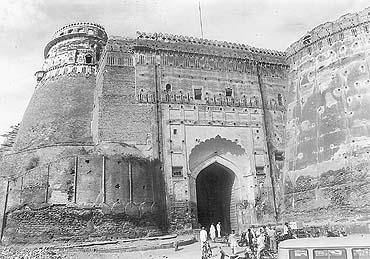Gobindgarh fort handed over
Army to handover Gobindgarh Fort, Amritsar, to Civil admin
Punjab Newsline Network
Monday, 06 October 2008
'The former Bhangian Da Kila, Gobindgarh fort returned to Local Government control==
Monday would witness a magnificent historical moment in the history of the Holy City when the Army would hand over Fort Gobindgarh to the civil administration.
This comes after several rounds of talks between the bureaucracy, political leadership and the Army authorities. On December 20, 2006 , Prime Minister Manmohan Singh had handed over keys of the historic fort to then Chief Minister Capt Amarinder Singh.
Maj-Gen P.S.Paul, VSM, General Officer Commanding, Panther Division, would hand over the reins of the fort named after Guru Gobind Singh by Maharaja Ranjit Singh, to Deputy Commissioner K S Pannu. Built in 1760, it was called Bhangian Da Kila (Fort of the Bhangis, one of the 12 Sikh misls), the fort occupies a unique place in Indian military history.
The Punjab Government has already chalked out an ambitious plan to tap the great tourism potential of the historic city which includes a plan for the adaptive re-use of Fort Gobindgarh as a national museum, displaying memorabilia of India's freedom struggle besides a contemporary history of the Indian armed forces, and the role of these forces in preserving the integrity of the country.
This monument was kept out of bounds from the people of Punjab for over 150 years. They have emotional attachment with the events related to Fort Gobindgarh. It had remained under the control of the Army since 1849, when Punjab was annexed by the British after the demise of Maharaja Ranjit Singh. It is expected that the Fort would be thrown open to the civilians who could witness the history of the monument and of the 150-year period.
In 1808, the fort was known as the fort of Gujjar Singh Bhangi. Later, it was re-built by Maharaja Ranjit Singh with the help of Jodh Singh. The legendary Maharaja Ranjit Singh strengthened the fortification of the fort in order to keep his treasures and treaties safely. A specially constructed "Toshakhana" was built right in the centre of the fort. The huge 'Toshakhana' was also used for storing the large amount of grains and provisions for the 12,000-strong Maharaja's army.
Made with brick and lime with a number of Army bastions and iron gates and 25 cannons on the ramparts that are now replaced with modern weaponry, the fort was constructed on a square pattern with a parameter of 1500 sq mt with two strong gates, four large bastions and a well-defined rampart.
The majestic entrance has been named 'Nalwa Gate', after General Hari Singh Nalwa, the great Sikh warrior in Maharaja Ranjit Singh's army who also had the Gumbad (Dome) on the Harmandar Sahib erected.
The other end of the fort is known as 'Keelar Gate' and it was rumoured that it was close to an escape tunnel which connected to the Lahore tunnel. But the Army authorities maintain that they have not been able to locate any such tunnel.
Of special interest to the denizens and tourists is the Darbar Hall, Hawa Mehal (lit. Room of the Winds) and the Phansi Ghar (hanging place) besides the "Dyer Bunglow" (Dwyer was the perpetrator of the Jallianwala Bagh massacre, the Bungalow is merely a crow's flight from the historical bagh where thousands of unarmed men, women and children lost their lives in the Freedom movement's bloodiest scene of carnage). The British Army had added these to the fort after the annexation of Punjab about 150 years ago.
Pannu said the administration and the Army authorities had worked out a solution. A part of the fort still held by the Army would be properly segregated to give safety to their unit and also provide suitable camouflage by raising a wall at a cost of Rs 2.50 crore. A special road has also been constructed to provide a separate entry to the Army establishment.

